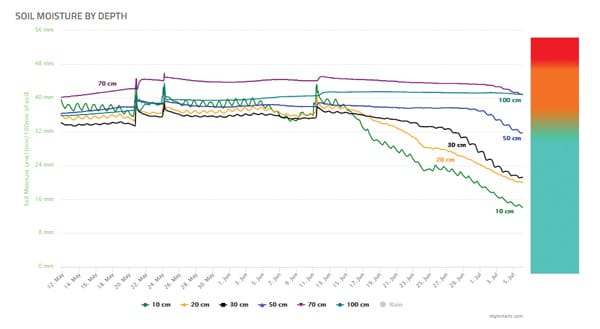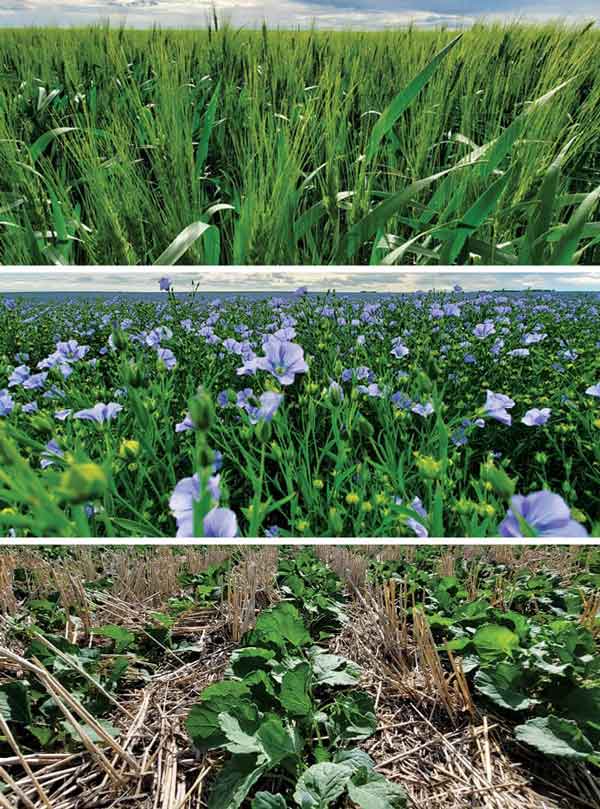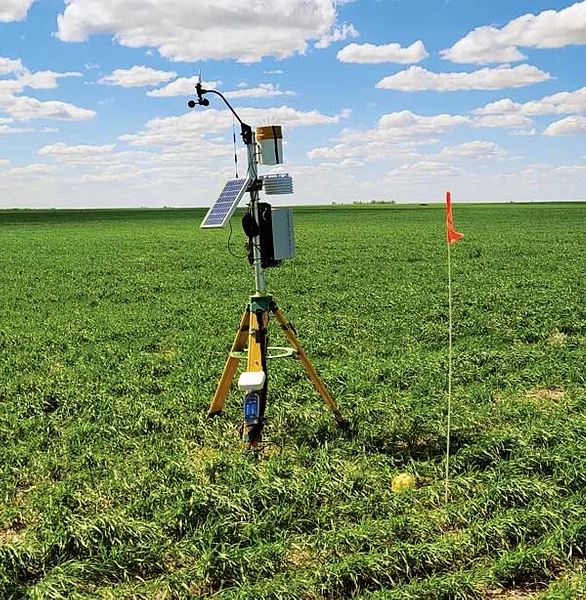I can watch my crop roots grow on my cell phone. Not literally, but I can tell you exactly what depth crops have rooted to in fields where we have installed weather stations with moisture probes.
Day by day, the soil moisture line stair-steps down the graph as roots dig deeper into the soil profile and deplete water to that point. It’s fascinating to watch water use. You can see when the plants wake up and start drawing water for the day. It’s like a live feed to the root zone.
While overwhelming at first — much like yield data was — the information pulled from the weather stations and moisture probes has helped guide management decisions and reveal questions we didn’t know we should be asking. Questions such as how to get stratified nutrients like phosphorus (P) and potassium (K) to the root zone with dry years in no-till. We’re still unsure of the solution, but we at least know when it’s a problem.
Our data collection goes beyond monitoring moisture. Data gathered from various sources has helped us make and observe improvements in our soils and production over years of no-till and input experimentation.
I farm with my wife, Stephanie and our three young sons, Asher (5), Grayson, (3) and Tristan (3 months), my older sister Sarah Leguee and my brother-in-law (married to my younger sister) Erik Nikolejsin. Together we grow a wide variety of crops on the flat plains of Saskatchewan. We were fortunate my parents, Russ and Sharon, started no-tilling in the early 1990s because it was normal when this generation took over.
Taking over new land, we’ve been able to see the value of the legacy our parents left us with land that has been no-tilled for decades. The high tillage, low-fertility fields required gobs of fertilizer to reach minimal yield targets. The soil provided nothing. No matter how much nitrogen (N) or sulfur we put on, we couldn’t get protein up to snuff on the cereals grown there.
Now, more than 10 years of no-till and continuous cropping later, those fields are completely different. Yields are up, protein is up and straw cover is quickly reclaimed by soil life. All these factors show me the soil has woken up and the biology is helping us with those crops.
Those results are easy to see. For fine tuning our no-till system, though, we dig deeper.

Check the Specs…
NAME: Jake Leguee
LOCATION: Leguee Farms
FARM: Fillmore, Sask.
YEARS NO-TILLING: 28
ACRES: 14,500
CROPS: Canola, durum, hard red spring wheat, yellow peas, red and large green lentils, flax and occasionally soybeans, barley, various peas and winter wheat.
Data Driven
Data feeds in from a variety of sources. We use that data — with the help of our agronomist — to make more informed decisions on seeding, fertilizer and fungicide applications. Here are our collection points.
- Visual assessment.
- Five strategically placed soil moisture probes/weather stations.
- Tissue testing — at every major crop stage on some fields depending on goals.
- EM38-MK2 soil electrical conductivity and RTK elevation mapping.
- Zone soil testing to ground truth other layered data.
- Satellite or high-resolution drone images.
- Yield data.
- Data from large in-field trials.
Both current and historic data helps us plan for variable-rate applications of various inputs so we can be prepared to move quickly. We spend a lot of time budgeting, data crunching, thinking and planning throughout the winter. We want to be as primed as possible, armed with all the information and Plans A, B and C when the growing season hits.
We get roughly 4 weeks in spring and early summer to make decisions that will influence the outcome for our crops. Once the middle of July hits, there’s not much we can do besides keep the bugs away. We need to be nimble and informed to render quick decisions in those weeks to make sure we get the best crop possible that year.
Historic yield data, elevation mapping, EM38-MK2 data (maps soil electrical conductivity which can impact nutrient uptake) and soil tests based on the zones that appear from layering those maps provide insight for early-season decisions.
The data determines variable-rate application of seed and nutrients. By lightening up on inputs over the identified saline spots that plague our region, for example, we’re able to limit waste and save money. Layering the data and using each data set to ground truth the others help us be confident in the prescription maps we follow to seed canola, durum, hard red spring wheat, peas and lentils.
At planting, we band a portion of our N as 28% UAN liquid ¾-inch to the side of the row and 1¾-inch deep. Logistically, it’s a lot easier to not put all the N on up front. We avoid the hassle and expense of purchasing and lugging around a monstrous air cart at planting.
It also helps hedge our bets. If all the N needed to grow an 80-bushel crop of durum is applied and it never rains, you’ve already committed those funds. You’re left to just hope the nutrients are still there the next year.
By applying only what the crop needs initially, then we can monitor soil moisture and take tissue samples to adjust expected yields based on conditions. With that information, we can determine if it’s worth applying more N or other nutrients.

Stutters in the soil moisture graph show how moisture moves throughout the day as plants wake up and start using it. It also is an indicator of how deep roots have moved in the soil profile.
In-Season Moisture Data
It’s well-known no-till works well in the limited moisture environment of western Canada. We need to conserve as much water as we can. While no-till certainly helps, it’s been interesting to unravel that knot further by more accurately tracking moisture.
In 2015, Dad had the idea to install weather stations and soil moisture probes. We now have five weather stations from Crop Intelligence that track temperature, rainfall, wind speed and measure crop-available moisture at depths of 10-, 20-, 30-, 50-, 70- and 100 centimeters. The data is wirelessly transmitted and can be accessed by our phones or computers at any time.
When the probes are pulled in the fall ahead of freeze, we know where we sit for soil moisture. That information lends some general guidelines to modify yield targets for crops planted the following spring.
Once the probes are reinstalled in spring, we actively watch soil moisture and use the current data to make decisions in that critical four-week window. If soils are drying out quickly we will be conservative with our N topdress application. If there’s an abundance of moisture and overall weather trends look good, we’ll go ahead and apply a higher rate of N.
The soil probes have also helped us understand how moisture moves in our specific field conditions.
For example, we’ve found when the ground is covered by residue, water will not leave our soils until a crop root pulls it out. Our soils are prone to compacting, and we have a natural hardpan layer.
If we can get water in the soil, it needs a plant or evaporation to bring it back out. That can be a good and bad thing on our flat fields. Standing water has created its share of low-production saline spots.
“We get roughly four weeks in spring and early summer to make decisions that will influence the outcome for our crops. We have to be ready to act...”
Data has also helped us understand how water is distributed in our soils and how deep crop roots reach. As of early July, durum roots were at 70 centimeters following the moisture down.
It’s good the roots are reaching this deep, but it also tells me the active roots are down deep, while soil testing tells me most of our P and K is stratified in the top 3 inches of our soil since I don’t incorporate it in our no-till system. If it rains an inch, that solves the problem by putting the roots close to the surface back in play. But that’s only if we get rain. We need to think about how to get those nutrients where they need to be in a dry year.
Moisture can also be a factor for determining if a fungicide is needed. The weather stations help determine if conditions are right in the canopy. However, that’s just one side of the triangle, as we still need the host to be there for that application to pay off.
We use the weather data as part of our decision process, but also lean on satellite or high-resolution drone images to target parts of a field that have a denser canopy and, therefore, are at higher risk for disease. For wheat, lentils and peas, we may determine if it’s worth it to apply fungicide to 2/3 of the field, but leave the other 1/3 alone.
Another place we use variable-rate application is on our sprayer. We have two John Deere sprayers. One has 11 section shutoffs on a 120-foot boom. Our newer sprayer, however, has ExactApply nozzle control system. The nozzles pulse and can be modulated individually.
When going around a pole, for example, the nozzles on the outside boom will pulse faster to ensure even spray application despite part the booms moving at different rates of speed.
We can use this technology to map saline spots and increase our glyphosate rates on our saline spots where high pH hinders efficacy.
Making data-guided decisions has improved productivity. We’re flat out getting more bushels on every crop we’re growing. Profitability is also up. We’re not investing in seed, fertility or fungicide treatments for places that don’t need them.
It’s not that we’re using less N, for example, we’re just not dumping 130 pounds of it on a spot that won’t benefit from such a high rate. Inputs are used where and when needed and we’re making those decisions with more confidence each year.

Growing a wide variety of crops in a continuous rotation, including durum, flax, lentils and canola, while also using no-till helps build soil biology. More active soils produce increasingly better yields and higher quality grains without increasing fertilizer rates.
Digging Into Depth
In 2017 we made a change that yielded a substantial benefit to our crops. We run 74- and 80-foot SeedMaster air drills. When we upgraded to independent depth control it made a huge difference in emergence on all our crops.
It wasn’t uncommon for us to plant a crop, not get a rain for a month or more and not get a crop. What we learned is it doesn’t have to rain to get a crop to emerge if seeds are at a uniform depth and secured equally uniform on-row packing pressure.
The change took hoe openers off the frame and put them on a long arm extending behind the frame. The packer tire follows just 1 inch behind the hoe. If the soil consistency or topography causes the hoe to lift or dip, the packer tire sticks right with it. Before, the packers were all at the back of the drill a full 8 feet from the opener.
Last year we planted and didn’t get rain for 1½ months. We still got 85% emergence on our canola. That’s allowed us to reduce our seeding rates, saving significant dollars.
Another thing that helps is using the SeedMaster Ultra Pro canola meter. It’s not singulating like a planter, but it does a nice job of laying seeds out in the soil. Overall, we’re getting better emergence and saving a ton on canola seed.
Experimentation is a vital part of what we do. We have to keep learning, trying and failing if we want to get ahead. We’ve tried fall crops and cover crops. Both have failed so far due to dry conditions. But at least we know.




![[Technology Corner] Autonomy & Robotics Take Center Stage](https://www.precisionfarmingdealer.com/ext/resources/2026/01/12/Autonomy--Robotics-Take-Center-Stage.webp?height=290&t=1768253759&width=400)


